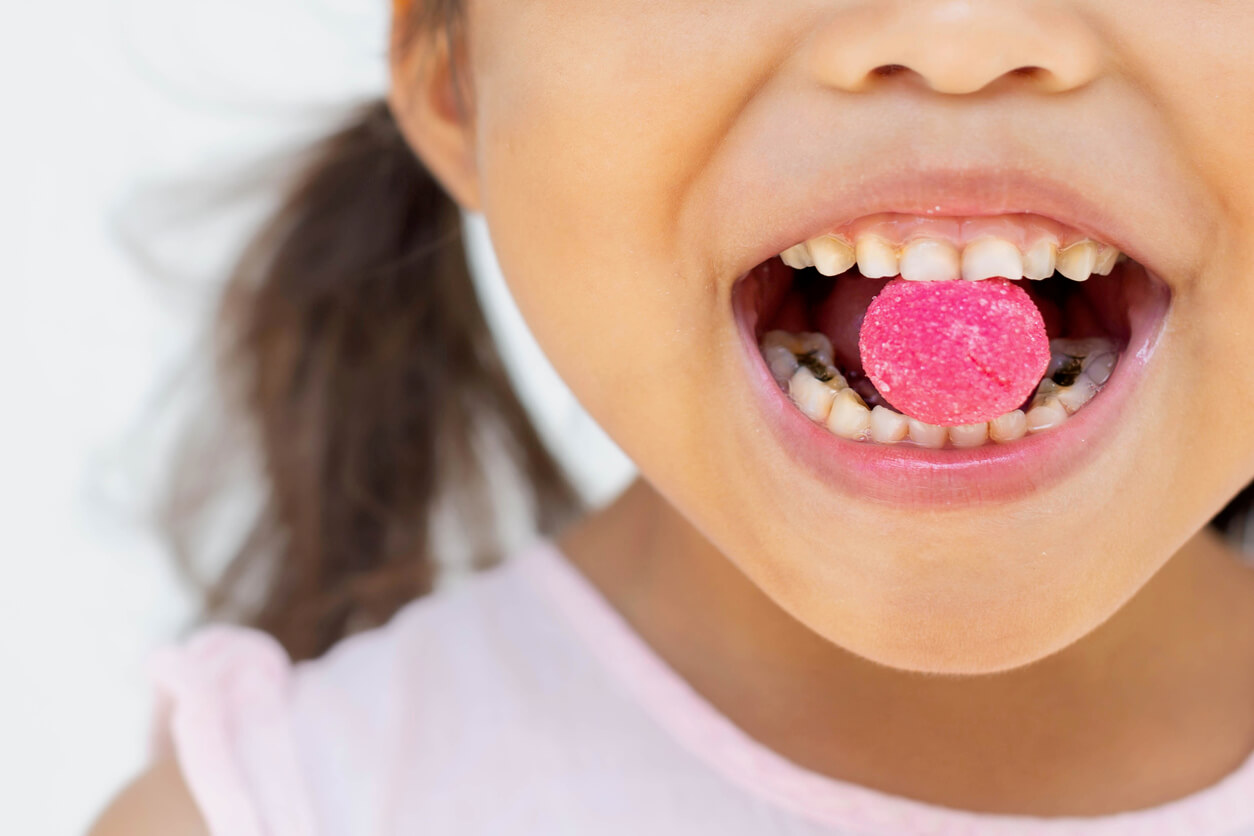The 3 Most Common Dental Problems in Children During Summer

In the following article, we’ll tell you about the three most common dental problems in children during the summer. Vacations, heat, long days, and outdoor fun invite us to live special moments. But you should know that during the summer, children are more susceptible to certain dental problems.
The summer season predisposes us to go on trips, excursions, and walks on the beach. And of course, to enjoy the swimming pool, tasty food, and even some mischief.
But certain changes in the routine can lead our child to end up with a broken tooth or a toothache. That’s why we want to provide you with the necessary information so that you can be attentive to your child’s oral health and help them have a wonderful time during their summer vacation.
Keep reading to learn about the most common dental problems in children during the summer and what measures to take to avoid them. Don’t miss it!
1. Dental cavities
Cavities are one of the most frequent diseases in childhood. And also, one of the dental problems in children that increases its incidence during the summer.
The greatest risk of suffering from this disease at this time is related to the changes in the routines of hygiene and care of the mouth. Children have different schedules during vacation and both they and adults tend to neglect (and even forget) the time to brush their teeth.
Poor dental hygiene favors the accumulation of bacterial plaque on oral surfaces. And the greater amount of bacteria in the mouth causes a greater production of acid, which is the substance responsible for the destruction of teeth.
This problem is compounded by changes in diet during the summer. The most common is an increase in the intake of sweets, ice cream, carbonated drinks, snacks, and unhealthy snacks. This increase in the consumption of simple sugars favors the proliferation of bacteria and the production of acid even more.
Cavities begin with spots on the teeth, and if they’re not treated in time, the disease progressively destroys the tooth: First with holes and then with breaking and falling out of the tooth. Even in the most advanced stages, it can affect the dental pulp and cause pain and deeper infections.

What to do to prevent tooth decay in the summer?
To prevent tooth decay in your children’s mouths, it’s essential to maintain oral hygiene moments. Turning toothbrushing time into a fun family activity can help to avoid skipping or forgetting it during the summer.
You can organize brushing contests, play games, or play songs during this time. Learning together how many teeth there are and what each one is for also favors the understanding of the importance of their care.
It’s also key to be careful with food. Maintaining a balanced, healthy, and varied diet during infancy favors the overall health of the child. And of course, it helps their teeth to develop correctly.
It’s also important to be attentive to the consumption of simple sugars and carbonated beverages. It’s true that children can indulge every now and then, but treats shouldn’t become the regular vacation menu.
Looking for fresh and healthy snack alternatives is a good idea. Children can be invited to participate in the preparation of their meals as part of entertainment and learning healthy habits.
2. Dental sensitivity
Another one of the most common dental problems in children during summer is dental sensitivity.
At this time, there’s a greater contrast in temperature between the food consumed and the body’s own temperature. When we’re hot, we prefer very cold food and drinks.
Dental sensitivity is an unpleasant, intense, sudden, and momentary sensation on the teeth. It’s perceived as a sudden pain in the tooth that makes it difficult to eat normally.
The cause of this discomfort may be the wear of the enamel or the retraction of the gums, which leaves areas of the nerve roots more exposed. In children, this is usually associated with excessive or very intense brushing techniques, the presence of cavities, gingivitis, the consumption of highly acidic foods and drinks, bruxism (tooth clenching and grinding), and the presence of fillings.
One way to avoid this problem is to restrict carbonated soft drinks, drinks, and highly acidic fruits. Also, be cautious with the consumption of ice cream and very cold foods, especially if the child complains when eating them.
And although it’s tempting to drink a glass of ice water filled with ice cubes on a hot day, it’s best to avoid them. It’s common for children to chew them and make the sensation worse, as well as run the risk of damaging and fracturing the teeth.
If the problem persists, it’s best to visit a pediatric dentist upon returning from vacation to evaluate the condition of the mouth. As we’ve told you, this sensation is related to the presence of other diseases.

3. Dental trauma
Summer’s a great time to play outdoors, run, jump, and release a lot of energy. Sometimes, these fun times end in falls and blows that can affect the mouth.
Contact sports, rough play, falls from swings, and pool decks often cause these types of accidents.
Hitting the mouth can result in a wide range of injuries:
- Wounds and cuts in soft tissues.
- Fractures of teeth.
- Mobility of the affected tooth.
- Change of the position of the tooth inward, outward, or sideways.
- Falling out of the dental element.
It’s very important that adults convey calm and reassurance to the child who’s been bumped, but also that they act promptly and seek professional help.
Whatever the type of injury suffered, the best thing to do is to contact the pediatric dentist immediately and tell them what happened. Then, follow their advice and go to the dentist as soon as possible, in order to assess and resolve the situation.
To avoid these types of dental problems in children during summer or any time of year, it’s advisable that they use mouthguards tailored to their needs during sports practice. In addition, it’s essential that adults know how to act in case their children bump their teeth.
Enjoy while taking care of themselves
Summer is a special season for children to enjoy themselves and have a good time, but without postponing oral health care.
Maintaining dental hygiene routines and controlling their diet is a good way to avoid the most common dental problems. Taking advantage of the vacations to visit the pediatric dentist is also a good idea, as it’s usually easier to get appointments during this period.
Enjoying the summer and avoiding dental problems in children is possible. With responsible parents who take care of their little ones, the whole family will be able to take advantage of this special season without suffering from mouth problems.
In the following article, we’ll tell you about the three most common dental problems in children during the summer. Vacations, heat, long days, and outdoor fun invite us to live special moments. But you should know that during the summer, children are more susceptible to certain dental problems.
The summer season predisposes us to go on trips, excursions, and walks on the beach. And of course, to enjoy the swimming pool, tasty food, and even some mischief.
But certain changes in the routine can lead our child to end up with a broken tooth or a toothache. That’s why we want to provide you with the necessary information so that you can be attentive to your child’s oral health and help them have a wonderful time during their summer vacation.
Keep reading to learn about the most common dental problems in children during the summer and what measures to take to avoid them. Don’t miss it!
1. Dental cavities
Cavities are one of the most frequent diseases in childhood. And also, one of the dental problems in children that increases its incidence during the summer.
The greatest risk of suffering from this disease at this time is related to the changes in the routines of hygiene and care of the mouth. Children have different schedules during vacation and both they and adults tend to neglect (and even forget) the time to brush their teeth.
Poor dental hygiene favors the accumulation of bacterial plaque on oral surfaces. And the greater amount of bacteria in the mouth causes a greater production of acid, which is the substance responsible for the destruction of teeth.
This problem is compounded by changes in diet during the summer. The most common is an increase in the intake of sweets, ice cream, carbonated drinks, snacks, and unhealthy snacks. This increase in the consumption of simple sugars favors the proliferation of bacteria and the production of acid even more.
Cavities begin with spots on the teeth, and if they’re not treated in time, the disease progressively destroys the tooth: First with holes and then with breaking and falling out of the tooth. Even in the most advanced stages, it can affect the dental pulp and cause pain and deeper infections.

What to do to prevent tooth decay in the summer?
To prevent tooth decay in your children’s mouths, it’s essential to maintain oral hygiene moments. Turning toothbrushing time into a fun family activity can help to avoid skipping or forgetting it during the summer.
You can organize brushing contests, play games, or play songs during this time. Learning together how many teeth there are and what each one is for also favors the understanding of the importance of their care.
It’s also key to be careful with food. Maintaining a balanced, healthy, and varied diet during infancy favors the overall health of the child. And of course, it helps their teeth to develop correctly.
It’s also important to be attentive to the consumption of simple sugars and carbonated beverages. It’s true that children can indulge every now and then, but treats shouldn’t become the regular vacation menu.
Looking for fresh and healthy snack alternatives is a good idea. Children can be invited to participate in the preparation of their meals as part of entertainment and learning healthy habits.
2. Dental sensitivity
Another one of the most common dental problems in children during summer is dental sensitivity.
At this time, there’s a greater contrast in temperature between the food consumed and the body’s own temperature. When we’re hot, we prefer very cold food and drinks.
Dental sensitivity is an unpleasant, intense, sudden, and momentary sensation on the teeth. It’s perceived as a sudden pain in the tooth that makes it difficult to eat normally.
The cause of this discomfort may be the wear of the enamel or the retraction of the gums, which leaves areas of the nerve roots more exposed. In children, this is usually associated with excessive or very intense brushing techniques, the presence of cavities, gingivitis, the consumption of highly acidic foods and drinks, bruxism (tooth clenching and grinding), and the presence of fillings.
One way to avoid this problem is to restrict carbonated soft drinks, drinks, and highly acidic fruits. Also, be cautious with the consumption of ice cream and very cold foods, especially if the child complains when eating them.
And although it’s tempting to drink a glass of ice water filled with ice cubes on a hot day, it’s best to avoid them. It’s common for children to chew them and make the sensation worse, as well as run the risk of damaging and fracturing the teeth.
If the problem persists, it’s best to visit a pediatric dentist upon returning from vacation to evaluate the condition of the mouth. As we’ve told you, this sensation is related to the presence of other diseases.

3. Dental trauma
Summer’s a great time to play outdoors, run, jump, and release a lot of energy. Sometimes, these fun times end in falls and blows that can affect the mouth.
Contact sports, rough play, falls from swings, and pool decks often cause these types of accidents.
Hitting the mouth can result in a wide range of injuries:
- Wounds and cuts in soft tissues.
- Fractures of teeth.
- Mobility of the affected tooth.
- Change of the position of the tooth inward, outward, or sideways.
- Falling out of the dental element.
It’s very important that adults convey calm and reassurance to the child who’s been bumped, but also that they act promptly and seek professional help.
Whatever the type of injury suffered, the best thing to do is to contact the pediatric dentist immediately and tell them what happened. Then, follow their advice and go to the dentist as soon as possible, in order to assess and resolve the situation.
To avoid these types of dental problems in children during summer or any time of year, it’s advisable that they use mouthguards tailored to their needs during sports practice. In addition, it’s essential that adults know how to act in case their children bump their teeth.
Enjoy while taking care of themselves
Summer is a special season for children to enjoy themselves and have a good time, but without postponing oral health care.
Maintaining dental hygiene routines and controlling their diet is a good way to avoid the most common dental problems. Taking advantage of the vacations to visit the pediatric dentist is also a good idea, as it’s usually easier to get appointments during this period.
Enjoying the summer and avoiding dental problems in children is possible. With responsible parents who take care of their little ones, the whole family will be able to take advantage of this special season without suffering from mouth problems.
All cited sources were thoroughly reviewed by our team to ensure their quality, reliability, currency, and validity. The bibliography of this article was considered reliable and of academic or scientific accuracy.
- Cruz Maldonado, D. M. (2022). Hábitos alimenticios y su relación con la caries dental en niños de 0 a 14 años. Revisión de la literatura (Doctoral dissertation, Quito: Universidad de Los Hemisferios 2022).
- Soria-Hernández, M. A., Molina, N., & Rodríguez, R. (2008). Hábitos de higiene bucal y su influencia sobre la frecuencia de caries dental. Acta pediátrica de México, 29(1), 21-24.
- González Sanz, Á. M., González Nieto, B. A., & González Nieto, E. (2013). Salud dental: relación entre la caries dental y el consumo de alimentos. Nutrición hospitalaria, 28, 64-71.
- Lorente, A. A., Cortés, O., Galera, M. D., Guzmán, S., & Canteras, J. (2016). Caries dental: influencia de los hábitos de higiene bucodental y de alimentación en niños en edad escolar. Acta pediátrica española, 74(10), 246-252.
- Organización Mundial de la Salud. (2021). Poner fin a la caries dental en la infancia: manual de aplicación de la OMS. Organización Mundial de la Salud. https://apps.who.int/iris/handle/10665/340445. Licencia: CC BY-NC-SA 3.0 IGO
- Bonilla Merino, L. R. (2018). Manifestaciones clínicas asociadas al bruxismo (Bachelor’s thesis, Universidad de Guayaquil. Facultad Piloto de Odontología).
- Sánchez, T. B., Avila, J. O. T., Segueo, M. S., & Gil, L. P. (2016). Traumatismos dentarios en niños y adolescentes. Correo Científico Médico de Holguín, 20(4), 741-756.
- García Ballesta, C., Pérez Lajarín, L., & Castejón Navas, I. (2003). Prevalencia y etiología de los traumatismos dentales: Una revisión. RCOe, 8(2), 131-141.
This text is provided for informational purposes only and does not replace consultation with a professional. If in doubt, consult your specialist.








